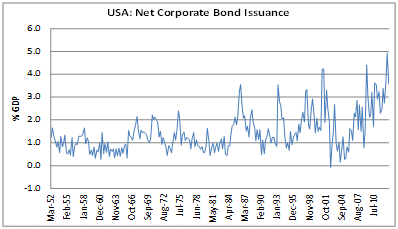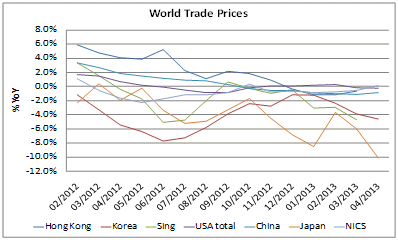Tyndall Monthly Commentary: Addicted to Quantitative Easing
QE is a habit that’s proving very difficult to break.
Wednesday, July 3rd 2013, 8:30AM
by Andrew Hunt

As part of a determined response to the Savings and Loans Crisis of 1989, the US Federal Reserve launched at that time what we would nowadays describe as a Quantitative Easing Policy (QEP). Perhaps positively, this policy was relatively successful in boosting the economy in the early 1990s; then, as the economy began to recover, the then FRB Chairman Greenspan decided to end the de facto QEP with a surprise modest rise in interest rates. Over the next nine months, global bond markets were to suffer their worst-ever bear market, emerging market equities fell heavily and global growth slowed until Greenspan was forced into relenting by the Tequila Crisis in Mexico and the FRB returned to an easier monetary stance.
The Federal Reserve’s next attempt at tightening – in early 1997 – then contributed to the Asian Financial Crisis and this once again forced a quick about-turn by the ever pro-growth Mr Greenspan. The Fed’s next attempt at a more restrictive stance occurred in 2000, but the NASDAQ Bubble that had formed in the meantime promptly burst and this event, together with the events of September 11, led to a new period of FRB accommodation that boosted asset prices but which finally seemed to be ending under the influence of higher inflation rates in early 2007. However, the Global Financial Crisis promptly occurred as policy tightened and this quickly forced the Federal Reserve into launching what became the official QEP Regime of 2009.
The FRB then attempted an exit from QE1 in 2010 by indicating that it was considering selling some of the debt securities that it had recently purchased and even raising interest rates, but this effort had to be aborted as the financial markets weakened sharply. Indeed, far from tightening as they had intended, the FRB was soon obliged to enact QEP Mark 2 and this propelled financial markets even higher until the FRB announced that it was going to try to stop buying further bonds. There was no mention of higher interest rates or actual bond sales by the FRB when it reached the end of QE2 but the financial markets nevertheless weakened until QE3 was introduced in the second half of last year. The markets’ addiction to QE seems to have been strengthening.
Under pressure from his staffers, though, Fed Chairman Bernanke finally indicated last month that he was beginning to consider buying fewer securities under QE3 (that is, not selling any bonds or raising interest rates – just buying fewer bonds) but nevertheless that was enough to send markets into a new tailspin until the Federal Reserve was able to wheel out enough Regional Governors to convince markets that there was not in fact going to be any tapering or rate hikes in the foreseeable future. Hence, as we write, QE3 and the US’s bias towards an accommodative monetary stance is back on track as both bonds and risk assets rally once again.
The lesson that we draw from this is that the US and indeed global markets have become remarkably addicted to further additions of QEP and the promise of easy liquidity over the last 20 years but that, like any addict, their cravings and needs are only increasing over time. However, to continue the analogy, addictions tend to lead to long-term health problems.
In the US, these longer-term issues are becoming all too apparent. The low interest rates associated with QEP have created a new boom in the housing market and although this may at first sight appear positive for economic growth, in reality we find that the household sector’s enthusiasm for renewed housing market investment is now causing them to divert cash flow from the retail sectors, with the result that consumer spending is failing to match people’s expectations. Housing has simply become a substitute for consumer spending and hence the revival in the housing market is having a minimal impact on reported GDP growth. This is not the 2006-7 model of the housing market that lifted consumption trends in the economy; households are now so focussed on housing that it is crowding out rather than boosting consumption. However, this is not the worst of the side effects of QEP.

As the Federal Reserve under its QEP regimes has steadily purchased much of the available supply of Treasury bonds and mortgage-backed securities, private sector investors in the bond markets have been forced to move into alternative instruments, such as corporate bonds. Indeed, the level of investor interest in the corporate bond market has reached unprecedented proportions as a result of the “shortage of Treasuries” implicitly created by the central banks and corporate issuers have clearly not been slow to respond to this situation. Over the last three or four years, the net issuance of corporate bonds has reached levels that have surpassed even those that were associated with the 2006 boom, the NASDAQ Bubble of the late 1990s and the corporate borrowing boom of the mid-1980s. Even cash-rich companies such as Apple have recently embarked on bond issues, apparently solely so that they can use the proceeds to buy in their own equity, boost their share prices and some would suggest then reward their executives with ever more lucrative share option schemes.
For the US corporate sector as a whole, we find that companies have become so focussed on financial engineering – issuing bonds so that they can buy in their own equity and thereby inflate their share prices – that they are now rarely focussing it seems on real investment in the real economies. We suspect that the financial engineering boom that successive QEPs have fostered is leading to the crowding-out of real investment spending on productive resources and together with the soft consumption environment noted above this is guaranteeing that overall economic growth rates will remain subdued and hence that QEP3 remains in place a while longer....
Certainly, the last few weeks of turmoil within the bond markets have revealed many of the contradictions and shortcomings in the current reliance on QEP. The Federal Reserve Chairman merely had to hint at a possible exit but this was enough to sink markets, but as markets declined the FRB was forced to re-introduce QEP3 or even to deny that it had even considered moderating it. It is for this reason that we find ourselves remarkably positive over the outlook for risk assets and bonds over the next few months. Rather perversely, we find that the Federal Reserve’s inability to exit QE should provide a powerful support for financial markets over the next few months and with the US likely to be at the forefront of the revival in financial market sentiment, we would also expect the US dollar to be quite well bid.
As we have noted, though, long term addiction is not without its costs. Japan over the last 25 years has been perhaps the most frequent QEP addict and the latest iteration – now known as Abe-nomics rather than QEP Mark V – has so far failed quite spectacularly to excite or stimulate Japan’s private sector. Far from persuading Japanese households and companies to spend and invest more, both households and companies evidently saved more as Abe-nomics was introduced and they even divested further from financial markets. The rise in the equity markets and even the fall in the external value of the yen that occurred during the first quarter were entirely the result of the actions of foreign investors.
Unfortunately, as the JPY fell, it unleashed a major deflationary force into world trade. Japan is clearly not a small price-taking economy; it is instead a large price-setting economy and the depreciation of the Japanese currency has unleashed powerful deflationary force into the world economy that has already sent the North Asian economies of Korea and, particularly, China into recessionary-like conditions. Indeed, we fear that China may actually suffer a technical recession in the next year, even if the official data may not show it.

Moreover, Japan’s deflationary impulse is already dragging CPI inflation rates down towards zero in much of the OECD from the US to Europe to New Zealand. Of course, as inflation rates have fallen, real interest rates around the globe have tended to rise despite the central banks’ actions. As it did in 1986 and 1996, the adoption of a weak Yen policy has unleashed powerful profit-sapping deflationary forces into the world economy.
Unfortunately, this trade price deflation has not been the only collateral damage that has been inflicted by Abe-nomics. As Japan’s Prime Minister has threatened wider budget deficits, a weaker currency and higher inflation, investors in Japan have understandably chosen to dump Japanese government bonds and the scale of JGB selling has been such that it is beginning to overwhelm even the Bank of Japan’s ability to stabilise the bond markets. In fact, Japanese private sector investors are selling so many bonds that they have effectively neutered Japan’s latest attempt at a QEP and liquidity growth is falling rather than expanding within the system, with an obviously negative impact on the economy and its financial markets.
If this Japanese crisis continues, then one of two things will occur. If Japanese savers decide to quit the Yen and invest more of their funds overseas, then the Yen will fall further, global deflation will likely accelerate and this will pose a grave danger to corporate profits and real interest rates in general that the financial markets may well find uncomfortable. If Japan’s bond market cracks and domestic yields move higher, though, then this could lead Japan’s savers to repatriate their now very substantial foreign assets and in so doing force the Yen and global interest rates higher. A stronger Yen might be beneficial to world trade but higher global bond yields resulting from any repatriation of funds by Japanese investors would be most unwelcome to both the financial markets and the global real economy.
It therefore seems to us that while we may be quite optimistic over the outlook for asset markets in the near term, over the longer term the outlook for bond prices and risk assets will depend on whether the Bank of Japan can regain control over the Japanese bond markets and how the domestic Japanese population will react to these issues. If the JGB market were to crack, then global real interest rates will rise either via higher nominal yields as a result of Japanese fund repatriations or as a result of faster rates of price deflation in the world as the Yen declines and we doubt that even the redoubtable Mr Bernanke would be able to insulate global markets from this potentially spectacular failure of Abe-nomics. Consequently, we would suggest that investors that chose to participate in the expected near term rally should therefore keep a wary eye on Japan’s bond markets and the behaviour of Japan’s investors.
Andrew Hunt
International Economist, London
Andrew Hunt International Economist London
| « Pathfinder: Gold’s glitter – going, going, gone, or has it? | Hamish Douglass Unplugged - Latest Video from Adviser Briefing - August 2012 » |
Special Offers
Comments from our readers
No comments yet
Sign In to add your comment
| Printable version | Email to a friend |









